The AMD Ryzen Threadripper 3960X and 3970X Review: 24 and 32 Cores on 7nm
by Dr. Ian Cutress, Andrei Frumusanu & Gavin Bonshor on November 25, 2019 9:05 AM ESTPower Consumption
One of our key conclusions from our Ryzen 9 3950X review is that AMD’s TDP number on the box was now somewhat a blurred line, with the processor instead taking the ‘Package Power Tracking’ or PPT value as its true peak power consumption. This meant that for a processor to have 105 W TDP on the box, the default PPT of 142 W meant that we saw power consumption around 142 W rather than 105 W. One concern going into this review is that AMD would take a similar line with the Zen 2-based Threadripper parts as well.
Both of the TR 3960X and TR 3970X processors have a list box TDP of 280 W, which is a new ‘record’ for high power consumption in a consumer CPU. In the enterprise space we see some specialist processors break the 400W mark, but those CPUs exist in environments with a variety of cooling methods and sound isn’t much of a concern. Conversely, these AMD processors will have to live in a box under someone’s desk, so there has to be a point where the TDP is too much. Last AMD generation was 250W, this one is 280W: if we’re not there already, then this should be a practical limit. AMD of course recommends liquid cooling with a good pump and a big radiator, so anyone buying one of these processors should look into spending at least another $120+ on a good liquid cooling system.
For our power consumption metrics, we performed our usual testing: using an affinity mask to limit the cores in use, implement a high-powered workload, and then measure the power readings 30 seconds in. We take the power readings from the processor itself, using the internal registers that are designed to regulate how much the processor does a form of turbo but also regulate temperatures and so forth. This method is broadly accurate, assuming the motherboard supports the external reporting of these values, but depending on the processor family it also gives us insights into how much power is being derived from the cores individually and the package as a whole.
Here’s what we get for the 24-core 3960X:
When a single core is active, it consumes ~13.5 watts. This slowly goes down when more cores get loaded, but at 6 cores loaded we are still consuming ~12 watts per core. Even at 16 cores loaded, we’re still around 10 watts per core. This is pretty impressive. At full core loading, we’re fluctuating between 6 and 11 watts per core, as workloads get moved around to manage core loading.
From the peak power perspective, we hit 280 W with 22 cores loaded. It drops off a bit after that, like we saw with the Ryzen 9 3950X, but not by much at this time. It should be noted that as we reach these higher values, out of those 280 W, around 205 W is being used by the cores, while 75 W or so is for everything else: that means memory controllers, PCIe root complexes, and the infinity fabric. This 75 W value doesn’t vary that much, starting at 68 W even at single core load. This indicates that either IF doesn’t take much power as more cores are used, or it is on all the time.
Moving to the 3970X, and we see a similar picture:
With more cores, the power is spread around a lot more. One core loaded tops out at 13 watts, and at 11 cores loaded we can still manage above 10 watts per core. When fully loaded, we move down to as low as 3 W per core, but it does average out to around 6 watts per core. Checking the frequency at this loading and despite the 3.7 GHz base frequency, we actually have all the cores at 4.0 GHz. 32 cores at 4.0 GHz? Yes please.
The peak power metrics rise to just over 280 W when we hit 23 cores loaded and stay there, with no dip after hitting the peak. It would seem that the 3970X appears better built in that regard.
If we comment on the power between the cores and everything else, we again get a 205-210 W value for the power in the cores. This leaves 75 W or so for the rest of the chip, almost identical to the 3960X, and again this doesn’t waver much from 1 core loaded to all-cores loaded.
What will be interesting to see will be when we get the 3990X in to test as comparison. I expect that 75W value to go up – even if it goes to 100W, that leaves 180W for 64 cores, or around 3 W per core. Based on my estimates, we could be looking at anywhere from 3.0-3.5 GHz per core, which actually fits in nicely with the frequencies of the EPYC 7H12 which is also a 64-core 280W part, but for the high performance compute market.
When comparing peak power consumption to all the other CPUs in our review, as expected our new CPUs are near the top of the charts.
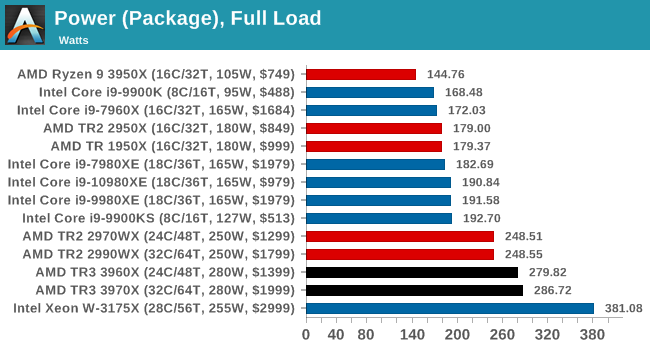
Only the unlocked 28-core from Intel peaks at a higher power, but funnily enough, that should only have a 255W TDP. So for four more cores, AMD’s peak power is still 100W below Intel’s. That’s the ‘power’ of the 7nm process node and some good quality chiplets.


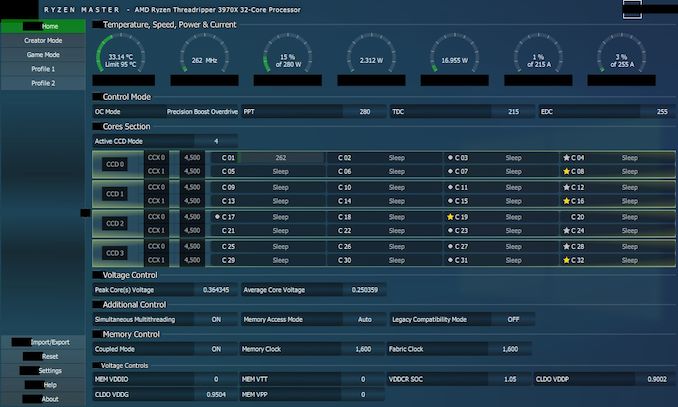
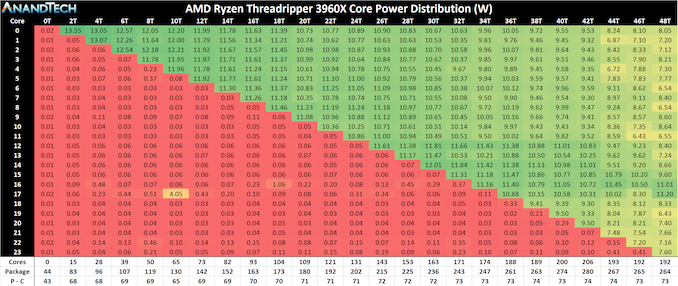
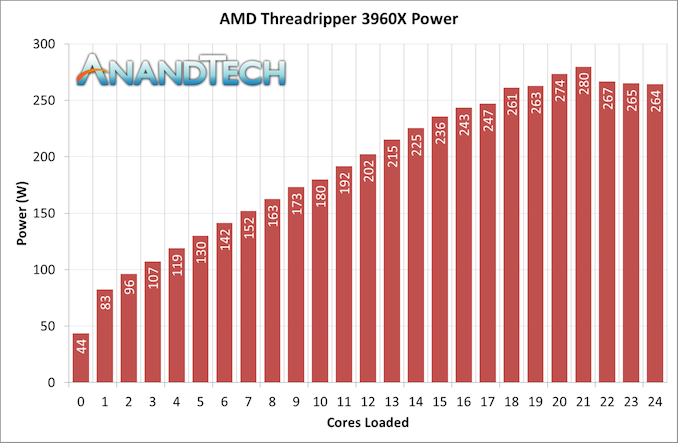
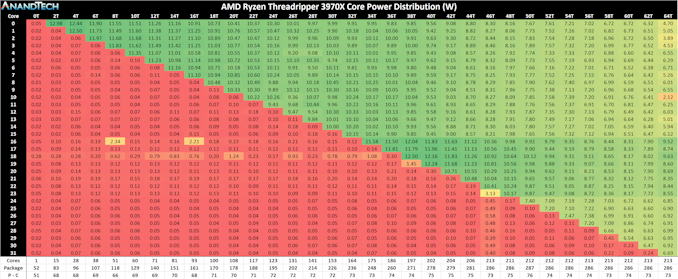
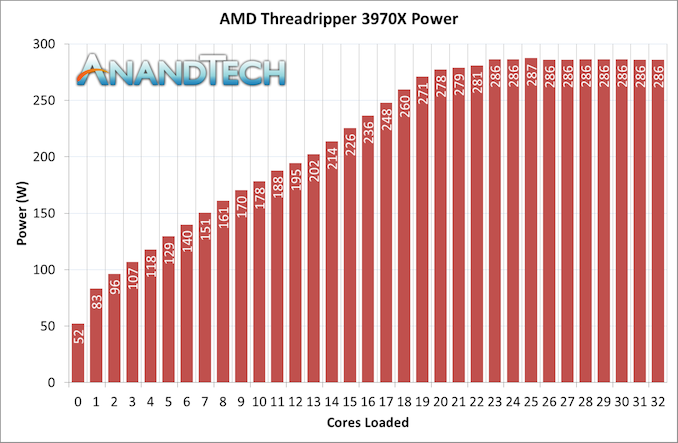








245 Comments
View All Comments
Xyler94 - Tuesday, November 26, 2019 - link
Gotta love the "But what about this" with you fanboys.Did AMD beat Intel to the X86-64 Race? Yes
Did AMD beat Intel to the 1Ghz Race? Yes
Did AMD beat Intel to the true dual-core arc? Yes
Does AMD still continue to innovate and bring us better products, despite their peanut funding compared to Intel, while Intel just tries to weasel their way through the market? Of course. Do you honestly believe if TR3 wasn't so amazing, that Intel would have reduced their 18 core part to 1k out of the goodness of their heart? If you think that, you're more of a fanboy than I thought.
It is still known as AMD-64 today, because AMD found the way to do both 32bit and 64bit X86 at the same time, and Intel has to license that tech from AMD. Without AMD, Intel would not be releasing 8 core CPUs today. The reason for their shortages isn't really due to high demand, it's due to varying demand of their products. the 6-8 core silicon is different from their 4 core ones, and they needed to manufacture separate LCC and HCC core i9/Xeons, further hogging their supply chain. And there's also the fact the 9900k is also a legitimately great CPU, so people want it, further hurting the supply chain. Intel did this to themselves due to years of complacency, so I don't feel bad at all.
blppt - Wednesday, November 27, 2019 - link
"Did AMD beat Intel to the X86-64 Race? Yes"They didn't beat Intel to anything---Intel was going with IA64, never going with x64, Then AMD threw a MASSIVE wrench into those plans, lol. Intel was forced to then copy AMD64 with EMT64 when Itanium flopped.
But make no mistake---if AMD didn't create x86-64, Intel wouldn't have either. We'd all be running Itaniums and Itanium clones.
Qasar - Wednesday, November 27, 2019 - link
actually, for the most part, the industry didnt want ia 64, it would me a redo of most, if not all of the software just to use it, before they could even use it, with AMD64, you could keep using existing 32 bit software, and transition of 64 bit, when you can, or wanted to. amd just found a better, and quicker way to 64 bit then when intel was trying to cram down every ones throats."
But make no mistake---if AMD didn't create x86-64, Intel wouldn't have either." and chances are, we could be still using 32 bit cpus, as i said above, most, if not all of the industry didnt want to have to re compile all of the software we used then. and wasnt itanium slower then x86 over all ?
ahh yep.. it was slower : " By the time Itanium was released in June 2001, its performance was not superior to competing RISC and CISC processors. " from https://en.wikipedia.org/wiki/IA-64
Qasar - Wednesday, November 27, 2019 - link
would me a redo of most = would mean a redo of mostblppt - Monday, December 2, 2019 - link
One of the big reasons Itanium/IA-64 failed was that its "backwards compatibility" (i.e. x86 emulation) was much slower than the native x86 cpus out at the time.So, while they wouldn't need to redo all that x86 software, it wasn't exactly speedy while emulating.
To take full advantage of the IA64 architecture, yes, they would need to rewrite a lot of software, but it would have *run* without a rewrite.
And that's where x86-64 stepped in. 64 bit memory addressing, perfect x86-32 performance at a lower price.
But Intel was never going to create x64 by themselves unless the new EPIC/VLIW IA64 hit some kind of performance brick wall, or people just kept coding to x86 anyways (which Itanium would run, but slowly).
Bear in mind that part of the reason it was slow in 2001, x86 and Power had been extensively optimized compilers for a decade (or more for x86) and IA64 was in its nascent stages. Since it was never adopted by the mass public (include home users, etc), development of IA64 never came close to the level of development and optimization of x86.
Qasar - Tuesday, December 3, 2019 - link
either way you look at it, it seems AMD is doing more to move the cpu farther, then intel does. AMD seems to be the one that innovates, while intel sleeps. i know some who is a fan of intel, will refute this, but think about it... AMD improves the cpu, and moves it forward, while intel stagnates and stifles it..eva02langley - Monday, November 25, 2019 - link
Desktop and HEDT is not Intel business anymore. Just a matter of time for server and laptop to eat the same bullet.eek2121 - Monday, November 25, 2019 - link
I wouldn't say that AMD fans are wrong. Look at AMD's revenue years ago vs today. Do you think the growth came out of thin air? No, AMD is eroding Intel's marketshare. It hasn't begun to show yet, because the last reported earnings did not include Zen 2 eating into things. More and more people are buying AMD, and as long as AMD continues to execute as they have (and even more so: they have to get into bed with OEMs), Intel will gradually begin to suffer. They already HAVE suffered. Drastic price reductions on their highest end parts.eek2121 - Monday, November 25, 2019 - link
Oh and I should add that Intel is in a lot more markets than AMD. In addition, Intel actually does a ton of fab work for other companies. Intel makes networking cards, storage, and much more. So in translation: Revenue is meaningless. Intel does not have endless amounts of cash to throw at creating new CPUs, GPUs (which are coming out in 2021), and chipsets. What matters is marketshare. For Intel, it's shrinking.tygrus - Tuesday, November 26, 2019 - link
AMD have taken market share from Intel but it's not uniform across all markets. Fancy brand names, servers and ultra notebooks are still dominated by Intel and where the end-user isn't making a choice. Enthusiasts using a local store to select parts & assemble are a small market that have swung to AMD.